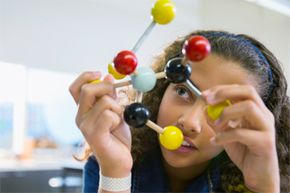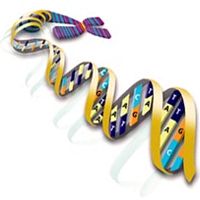To understand a monomer, picture a set of beads made for a very young child, designed to interlock together. Each individual bead is an item on its own, but it can also snap tightly together with another bead, forming something entirely different.
The term monomer comes from the Greek words mono, meaning "one," and meros, which means "part." Put them together to form "one part," and they describe a monomer: any one molecule that joins with other monomers to create a larger molecule. One common natural monomer is glucose, for example, which commonly bonds with other molecules to make starch and glycogen.
Advertisement
Just like the interlocking beads, the monomers must connect properly. This occurs through a chemical process called polymerization, where two separate molecules bind together by sharing pairs of electrons, forming a covalent bonds [source: Larsen]. The two monomers joining together can be the same kind, or they can be different.
The result of this union is called a polymer, which is a structure made from many repeating monomer units, forming a long chain [source: Larsen]. The capacity to bond with at least two other monomer molecules is a characteristic of monomers called polyfunctionality [source: Brittanica]. The number of molecules a monomer is able to bond with is determined by the number of active sites on the molecule where covalent bonds can be formed – you only have two hands, for instance, so the maximum number of other people you can hold hands with at any one time is two.
The number of these bonds dictates the resulting type of structure. If a monomer can bond with only two other molecules, the resulting polymer has a chain-like structure. If it can bond with three or more molecules, three-dimensional, cross-linked structures can be formed [source: Innovate Us].
Most monomers are organic [source: Brittanica]. Amino acids, for instance, are natural monomers that can polymerize to form proteins. Nucleotides, which are found in the cell nucleus, polymerize to form DNA and RNA. Some monomers, on the other hand, are synthetic; a common man-made monomer is vinyl chloride. Through polymerization, vinyl chloride monomers combine to form the polymer polyvinyl chloride (PVC) – one of the oldest synthetic materials, and an abundantly used form of plastic. Building materials, bottles, toys and even fashion products use some form of PVC [sources: Innovate Us, PVC].
Next time you reach for a plastic water bottle, think of that solitary child's bead just waiting to be put on a string. In order to form the bottle you're holding, monomers bonded together, resulting in a plastic polymer.
Advertisement


